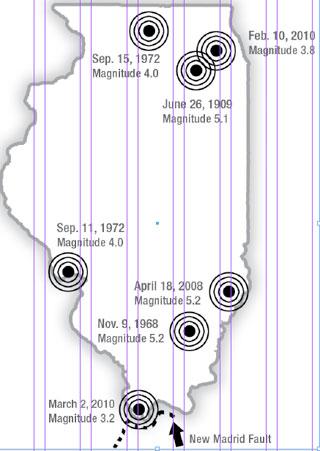Earthquakes wake up call to world
The devastating earthquakes to hit Haiti and Chile in recent memory have been a wakeup call for the rest of the world.
Illinois also experienced an earthquake in early February that was felt in the northern part of the state.
It is a cause for concern for Illinoisans, because the active New Madrid fault is located on the border of Southwest Illinois near the town of Cairo.
In the past three years alone, Illinois has had two notable earthquakes. The first occurred in April 2008 with a magnitude 5.4 and was centered in West Salem. The second one occurred in early February in the towns of Virgil and Sycamore and measured as a magnitude 3.4.
These earthquakes are small in comparison to the magnitude 8 earthquake in Chile and magnitude 7 earthquake in Haiti.
A magnitude 4 earthquake can cause moderate damage, while a magnitude 7 earthquake is capable of widespread and heavy damage.
John Paul Stimac, department chair and associate professor of geology/geography, said that these frequent earthquakes are no cause for concern.
“The number for earthquakes worldwide is normal for the year so far,” Stimac said.
“Earthquakes with a magnitude of 8 or higher will occur once a year, and earthquakes with a magnitude of 7 occur three to five times a year. Earthquakes are a daily occurrence by the New Madrid Fault with some earthquakes even measuring negative on the Richter scale.”
An earthquake that measures negative on the Richter scale will break rock when moving and releases energy. The movement and energy release is so small that it cannot be felt by humans, only instruments.
That does not rule-out the possibility of any large-scale earthquake happening anytime soon. The last massive earthquakes from the New Madrid Fault happened in 1811 and 1812, separated by three months. These earthquakes registered at an 8 on the Richter scale and were felt across the Midwest, including St. Louis and Chicago. These earthquakes could be felt as far away as Boston.
“It was such a large earthquake that it shook church bells in Boston and created Reelfoot Lake in Tennessee,” Stimac said.
“An earthquake of that magnitude really only occurs every thousand to two thousand years, but that doesn’t mean that it cannot happen again tomorrow or next week.”
The possibility of a large-scale earthquake occurring in the area brings to question if the school’s buildings are up to code for large earthquakes.
“If an earthquake larger than a magnitude 6 would occur, it would cause damage to the building(s), because the buildings are made from brick,” Stimac said. “Brick is strong when it is compressed but can break when a force is shaking it from side to side.”
Stimac also noted that the bedrock that Eastern’s campus and most of Illinois is over is glacier rock, which, unlike regular bedrock material, is prone to shake more during an earthquake. This is not a cause for concern, but Stimac said he thinks people have become more aware after the recent earthquakes.
“(In) some way, earthquakes are good, because it causes people to think about natural hazards,” Stimac said. “The university offers classes with risk management as a way to prepare students for any situation, including earthquakes.”
Steven Puschmann can be reached at
581-7942 or
Earthquakes 2010 on Dipity.
Earthquakes wake up call to world

A new football stadium, renovations to Lantz Arena and two other new facilities are all part of the “master facility plan” unveiled by Athletic Director Barbara Burke at Wednesday’s Athletic Director’s Gala in Effingham.





































































